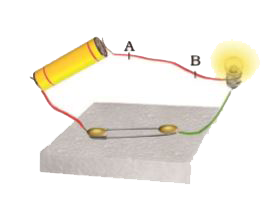In the absence of applied potential, the electric current flowing through a metallic wire is zero because
The electrons remain stationary
The electrons are drifted in random direction with a speed of the order of cm/s.
The electrons move in random direction with a speed of the order close to that of velocity of light.
Electrons and ions move in opposite direction.
The correct Answer is:B
The drift velocity is small and random. It is of the order of cm/s. When the potential is applied, the electric field is setup with the speed of light. When no potential is applied, the random motion does not contribute to the motion of the charge in a specific direction.
Topper's Solved these Questions
- CURRENT ELECTRICITYBook:MODERN PUBLICATIONChapter:CURRENT ELECTRICITYExercise:MULTIPLE CHOICE QUESTIONS ( LEVEL-II)
Explore 54 Videos
- CURRENT ELECTRICITYBook:MODERN PUBLICATIONChapter:CURRENT ELECTRICITYExercise:MULTIPLE CHOICE QUESTIONS (PARAGRAPH QUESTIONS)
Explore 2 Videos
- ATOMS, MOLECULES AND NUCLEIBook:MODERN PUBLICATIONChapter:ATOMS, MOLECULES AND NUCLEIExercise:Recent Competitive Questions
Explore 40 Videos
- DESCRIPTION OF MOTION IN ONE DIMENSION Book:MODERN PUBLICATIONChapter:DESCRIPTION OF MOTION IN ONE DIMENSION Exercise:Revision Test
Explore 45 Videos
Similar Questions
The electric current passes through a metallic wire produces heat because of :
View SolutionElectrical current is the flow of charged particles. The electric current flows through a wire the same way as how water moves in a river. The electricity is nothing but the flow of electrons.

What does the graph signify?
View Solution
Knowledge Check
Electric current can flow through
AairBhuman bodyCboth (a) and (b)Dneither (a) nor (b)The electric current passing through a metallic wire produces heat because of
Acollision of conduction electrons with each otherBcollisions of the atoms of the metal with each otherCcollision of the conduction electron with the atoms of the metallic wireDnone of theseThe electric current passes through a metallic wire produces heat because of :
Acollisions of conduction electrons with each otherBcollisions of the atoms of the metal with each otherCthe energy released in the ionization of the atoms of the metalDcollisions of the conduction electrons with the atoms of the metallic wire
When an electric current flows through a copper wire AB as shown in Figure14.1, the wire

View SolutionThe flow of the electric current through a metallic conductor is
View SolutionElectrical current is the flow of charged particles. The electric current flows through a wire the same way as how water moves in a river. The electricity is nothing but the flow of electrons.

What does the graph signify?
View SolutionElectrical current is the flow of charged particles. The electric current flows through a wire the same way as how water moves in a river. The electricity is nothing but the flow of electrons.

What does the circuit diagram signify?
View SolutionThe direction of conventional current flowing through a metal due to applied potential difference or electric field is
View Solution
